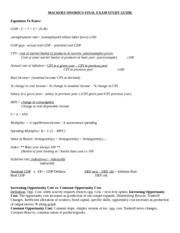Macro Final Exam Review ECO 212 Macroeconomics in a Global Economy ECO 212 Final Exam Review / / / / / / / / / / ECO 212 does have a comprehensive final exam. There will be 80 multiple choice questions and NO extra credit essay. Students always ask me for suggestions on how to study for the final. Hopefully, you have been preparing for the final throughout the semester. The best place to find what you need to know is the OUTCOMES/MUST KNOW lists found on the link on our Blackboard site. THERE ARE SOME CHAPTERS THAT ARE MORE IMPORTANT THAN OTHERS. These are usually the chapters with the new models (i.e.
- Macroeconomics Exam Study Guide
- Macroeconomic Theory Final Exam Study Guide
- Intermediate Macroeconomics Final Exam Study Guide
Graphs) and concepts. You can probably figure out yourself which chapters they are, but here is a list:. chapter 1: production possibilities graph. chapter 3: supply and demand graph. chapter 20: using the production possibilities graphs to determine comparative advantage. chapter 12: AD/AS graph.
chapter 7: calculating GDP,. chapter 10 and 13: calculating and using the multipliers.
chapters 14, 15, 16: showing how monetary policy works on the set of 3 graphs THE TEXTBOOK DOES HAVE A VERY GOOD REVIEW SECTION at the end of each chapter that you may want to look at. 15 MINUTE YOUTUBE VIDEO.
A good, but quick, review of a lot of material covered in our course: No matter how you review for the final, you should be able to do the type of problems found in:. REQUIRED ACTIVITIES. CLICKER QUIZZES. PREQUIZZES. TOPICS BY CHAPTER Anything covered during the semester can be on the final exam, but there are some topics that are more likely to appear there. Note that the chapters listed below may include pages from other chapters. For the exact reading LESSONS see the link on Blackboard Chapter 1.
What is structural adjustment, what are its policies, and why are countries doing it?. What is economics? What role does scarcity play?. What are the '5 Es' of economics and how does each one reduce scarcity?. What are the 4 factors of production (types of resources)?.
What is the production possibilities table/graph (PPC)? What does it show?. What are the assumptions behind the PPC?. How can we demonstrate the following using the PPC?. the necessity of choice. opportunity costs. law of increasing costs.
Macroeconomics Exam Study Guide
unemployment. productive inefficiency.
economic growth (EG). present choices, future possibilities. optimum product mix?. Give two definitions of EG. Understand the simple circular flow model Chapter 2. Compare command and market economies. What is the 'coordinating problem' and the 'incentive problem' found in command economies?.
What are the characteristics of market (capitalist) economies?. What is the 'invisible hand' and how does it promote efficiency?. What is consumer sovereignty?. Understand the important role of prices in a market economy. Understand the connection between the market economy and the 5Es.

Government Finance Chapter 3. THIS CHAPTER IS IMPORTANT. Be able to define and graph demand and supply.
Macroeconomic Theory Final Exam Study Guide

Intermediate Macroeconomics Final Exam Study Guide
Final Exam Study Guide After Midterm Class t9 What is a budget deficit/surplus? A deficit is a shortfall of revenues over expenditures. A surplus is an excess of revenues over expenditures. Deficit/surplus: typically defined per year/ fiscal year Does it make sense to look at the deficit in nominal numbers?
Most often not. You should always look at it in relative terms, for example: as a percent of GDP as a percent of Government Revenues Cyclical deficit: the part of the deficit that exists because the economy is operating below its potential level of output.
Structural deficit: the part of the budget deficit that would exist even if the economy were at its potential income.